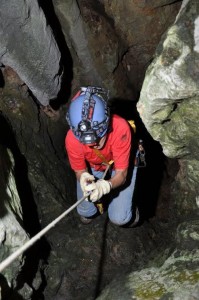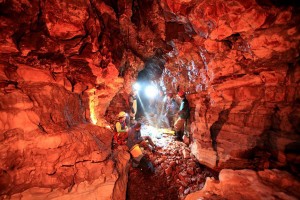
Some people don’t enjoy finding themselves between a rock and a hard place, but for cavers, it’s all part of the adventure.
Caving, which is also known as spelunking or potholing, became popular in America during the 1940s and 1950s. In the beginning, the goal of most caving expeditions was to survey new areas and explore unmapped territory.
Today, some people explore caves as part of scientific studies, while others work to surpass obstacles like deep water or high walls that stumped cave explorers in the past. For Jeff Baird, a computer programmer from Sandy who specializes in business intelligence, caving is a hobby he’s taken up simply for fun.
Baird said his father introduced him to caving.
“I grew up in Utah with a very adventurous father who spent a lot of time with us in the outdoors,” Baird said. “We started doing climbing-related adventures when I was 12 and decided to try a cave on the Wyoming/Montana border called Bighorn Cavern. Visiting the cave became a yearly tradition that we continue to do with my boys.”
Baird, enamored with caving from the beginning, has visited caves throughout Utah and surrounding states.
“It’s difficult to narrow down one thing about caving that I like most. I like the challenge of vertical caves requiring descending and ascending gear,” Baird said. “But I also like the exploration and discovery. Seeing amazing cave formations is always something I enjoy as well.”
While some caves can easily be explored without specialized equipment, other caves are technical, meaning they require certain types of gear. The amount and type of gear a caver needs depends heavily on the type of obstacles lurking beneath the earth’s surface.
“The minimum equipment to safely explore a simple, but wild cave would include a helmet and three sources of light,” Baird said. “For vertical caves, one needs descending equipment and an ascending system of some kind. In caves that are difficult to navigate, a map and some kind of cave markers are important to keep from getting lost.”
There is no shortage of caving stories where expeditions have gone from fun to fatal. In June of 2014, an experienced German caver spent 11 days trapped almost 4,000 feet underground due to an injury. Nearly 730 people from various European countries participated in his rescue, according to The New York Times.

In a 2009 incident a bit closer to home, a Utah man died after getting stuck in a narrow passage inside Nutty Putty Cave, located west of Utah Lake in Utah Valley. Officials sealed off the entrance to the cave to prevent the possibility of someone else making the same deadly mistake, according to the Deseret News.
Because of the high risks involved, cavers need to plan properly before going underground. Debbie Spoons, a cave rescue expert from Springville, is all too familiar with some of the mistakes new cavers make.
“New cavers should never go without an experienced caver. They should never go alone, always have the proper equipment and have correct emergency supplies,” Spoons said. “They should also make sure that at least two different people know where they’re going, who they’re going with, when they’ll be back and the exact location of the cave they’re going to.”
Baird also recommends wearing tight clothing and pulling back loose hair. “One time a girl caving with us got her hair caught in the rappel device as she was halfway down a cave entrance. Our experience aided us in resolving the issue, but it was a reminder to be vigilant in double checking things before descending,” Baird said.
“Overconfidence, ill-preparedness and improper equipment are other mistakes beginning cavers fall prey to,” Baird said. “Like so many things in the outdoors, it can be easy to underestimate a cave, or overestimate one’s ability.”
For people who are new to caving and don’t have friends with caving experience, there are organizations with expert cavers who are willing to show beginners the ropes. Local grotto groups, which are subgroups of the National Speleological Society, meet all across the United States.
Since some cavers choose not to reveal their favorite spots, grottos are also a good way to find caves that aren’t publicized elsewhere. People living in Utah County can attend the monthly Timpanogos Grotto meetings.




